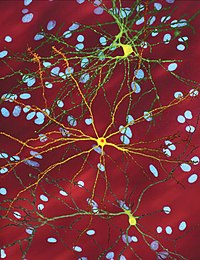
Photo from wikipedia
Mortality from liver disease conditions continues to be very high. As liver diseases manifest and progress silently, prompt measures after diagnosis are essential in the treatment of these conditions. Microfluidic… Click to show full abstract
Mortality from liver disease conditions continues to be very high. As liver diseases manifest and progress silently, prompt measures after diagnosis are essential in the treatment of these conditions. Microfluidic organs-on-chip platforms have significant potential for the study of the pathophysiology of liver diseases in vitro. Different liver-on-a-chip microphysiological platforms have been reported to study cell-signaling pathways such as those activating stellate cells within liver diseases. Moreover, the drug efficacy for liver conditions might be evaluated on a cellular metabolic level. Here, we present a comprehensive review of microphysiological platforms used for modelling liver diseases. First, we briefly introduce the concept and importance of organs-on-a-chip in studying liver diseases in vitro, reflecting on existing reviews of healthy liver-on-a-chip platforms. Second, the techniques of cell cultures used in the microfluidic devices, including 2D, 3D, and spheroid cells, are explained. Next, the types of liver diseases (NAFLD, ALD, hepatitis infections, and drug injury) on-chip are explained for a further comprehensive overview of the design and methods of developing liver diseases in vitro. Finally, some challenges in design and existing solutions to them are reviewed
Journal Title: Micromachines
Year Published: 2022
Link to full text (if available)
Share on Social Media: Sign Up to like & get
recommendations!